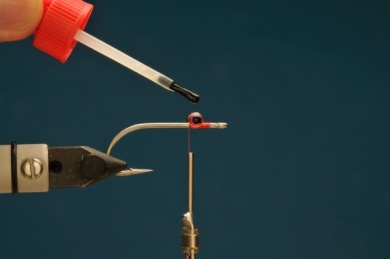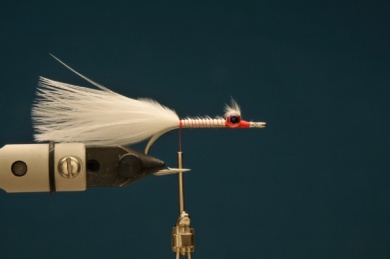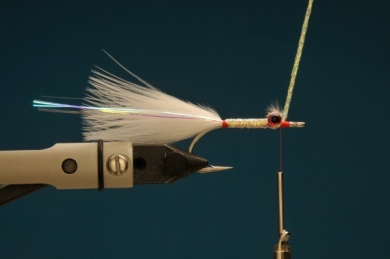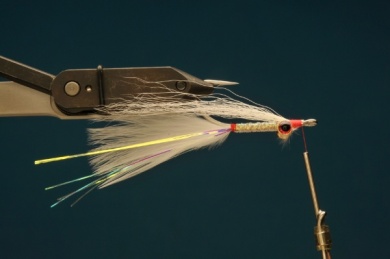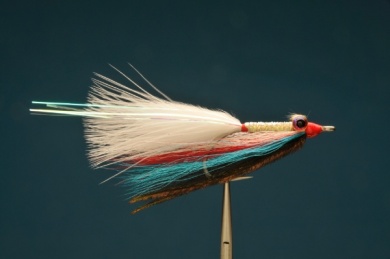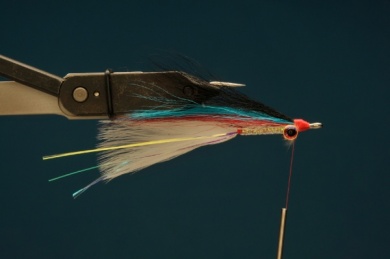In our visit to the Zambezi River searching for tiger fish the most effective flies were Clouser Minnow-like streamers. In the Lower Zambezi, in Zambia, where we fished, there are many fishing eagles that watch the river surface from the top of the trees, looking for moving fish. This is why Zambezi View more...In our visit to the Zambezi River searching for tiger fish the most effective flies were Clouser Minnow-like streamers. In the Lower Zambezi, in Zambia, where we fished, there are many fishing eagles that watch the river surface from the top of the trees, looking for moving fish. This is why Zambezi fish learn from early stages that they must swim far from the surface and go back down really fast in case they rise. The fishing is done past the uncontrollable trees that the Zambezi dragged to the river during the rain season; therefore, Clousers are the right flies because they almost never get snagged and they sink fast as soon as they hit the water, something that enables us to take advantage of the small spots where we must place our fly. Tiger fish have an amazing set of teeth that makes hooking them complicated, especially if the fly has lots of tying material. This is why Clousers, being so thin, do a great job.Imitating the fish that tigers prey on, we tied these colorful Clousers that we baptized as “Zambezi Rippers” for they were extremely effective. We will also try these when fishing for the great golden dorados of the upper Paraná River in Argentina, which in some areas is quite similar to the Zambezi.
Move the mouse over the image to zoom in the fly.
Touch the image to zoom in the fly.

List of materials
Tying MaterialsHook: Daiichi 2546. 1/0 and 2/0 at the Zambezi River.Thread: 6/0, red.Eyes: Sparkle Eyes by Montana Fly.Tail: white marabou feather and six pearled flashabou strips.Wing: white bucktail, then red, turquoise blue, and black.Back: peacock fibers, the ones from the feather with the eye if possible.
Steps
Step 1
Place the thread and tie the eyes with X-shaped turns, cementing everything with cyanoacrilate or epoxy. The eye is on the opposite side of the hook bend so the fly works upside down.
Step 2
Pick a marabou feather with long, even fibers and then remove the shorter fibers. If possible, use a feather whose raquis is the finer you can get. Tie the feather past the eyes and, with even turns, take it to the bend of the hook, where we will do several neat and tight turns, reinforcing the tie in that place.
Step 3
Next to the eyes, tie three pearled flashabou strips at each side of the tail, a bit longer than the tail in order to imitate the transparency of the minnow fins. Then, tie the diamond braid right behind the eyes, take it to the back reinforcing the tie and wrap with even turns towards the eyes. The body is finished when the braid goes past the eyes; tie it and trim. Leave a red thread bit visible close to the hook bend, it makes the fly more attractive. View more...Next to the eyes, tie three pearled flashabou strips at each side of the tail, a bit longer than the tail in order to imitate the transparency of the minnow fins. Then, tie the diamond braid right behind the eyes, take it to the back reinforcing the tie and wrap with even turns towards the eyes. The body is finished when the braid goes past the eyes; tie it and trim. Leave a red thread bit visible close to the hook bend, it makes the fly more attractive.
Step 4
Carefully, even out a white bucktail strap of 20 to 30 hairs and tie it in a way that it is shorter than the marabou tail. It is better to cement each deer strap with some cyanoacrilate, so the fly lasts longer.
Step 5
After tying the white deer strap, tie a red one, a turquoise blue one, and a black one in the same way. The straps should be similar in thickness. The finished wing should have the right size for a streamer. A traditional deer hair Mickey Finn, classic and well known, is a good model.To finish our Zambezi Ripper, tie four to six peacock fibers (single-eye fibers if possible) and shape a neat conic head, cementing with cyanoacrilate and then with lacquer or epoxy. The tridimensional eyes, as seen View more...After tying the white deer strap, tie a red one, a turquoise blue one, and a black one in the same way. The straps should be similar in thickness. The finished wing should have the right size for a streamer. A traditional deer hair Mickey Finn, classic and well known, is a good model.To finish our Zambezi Ripper, tie four to six peacock fibers (single-eye fibers if possible) and shape a neat conic head, cementing with cyanoacrilate and then with lacquer or epoxy. The tridimensional eyes, as seen on the finished fly, make this fly really attractive. It’s a fly that works really well fished between the sunken tree branches.
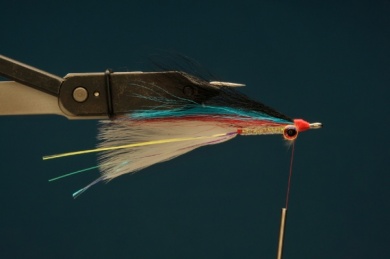
Step 6
Finished fly. View I.
Step 7
Finished fly. View II.

